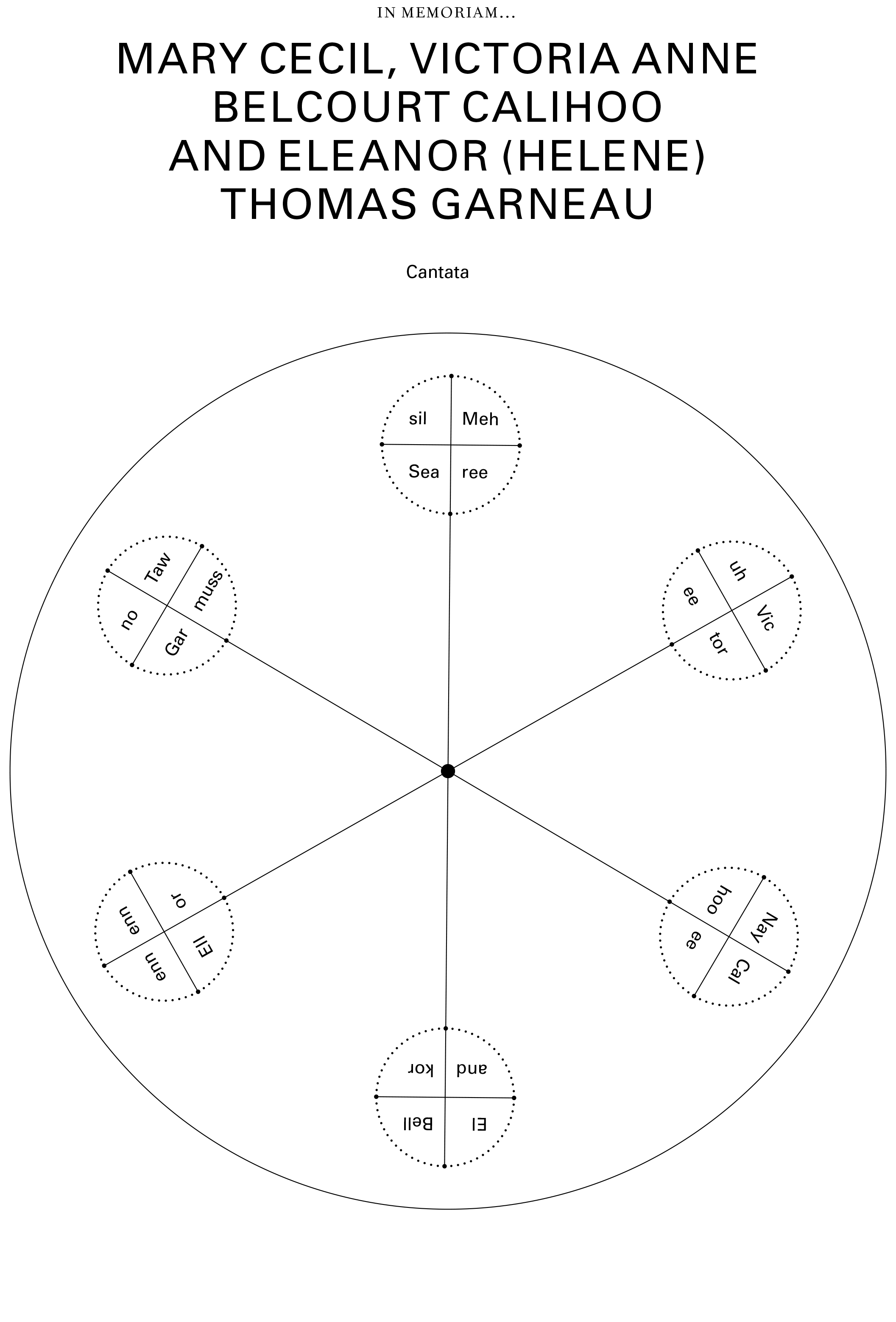An Afterword for in memoriam…

By Candice Hopkins
The text of this essay originally accompanied Postcommodity and Alex Waterman’s 2017 publication in memoriam… Mary Cecil, Victoria Callihoo (née Belcourt), and Eleanor (Helene) Thomas Garneau, curated by Ociciwan Contemporary Art Collective, who assisted in preparing it for publication here.
Invisible Brown Women
In Edmonton Alberta last summer, the poet Marilyn Dumont said some words that stuck with me. In a poem as part of her book The Pemmican Eaters she detailed the lives of the brown women who were always by the side of their husbands—men whose names do grace the pages of history books, street signs, archives and museums. When their wives are pictured in the pages of those same history books and files in archives, they are more often than not nameless, silent witnesses. One of the women that Dumont named is Eleanor Garneau. She made clear that what made these women’s lives special was not their role in the domestic sphere—all-too-often qualified as the natural domain of women particularly in the 1800s—what made their lives worthy of note was their leadership as council, decision-makers, and diplomats not only in local economies but within the economy of the new nation of Canada. It was those Métis and First Nations women—those whose names need to be written, sung, inscribed and known—who taught foreign men how to set traps, how to sew thick, smokey moosehide, how to attract beavers with the scent from their glands and how to track the animals that the colonial machine desired: mink and fox, bear and moose, lynx and bobcat, otter and beaver, always beaver. It was Eleanor Garneau who performed one of the subtlest rebellions of all, when in front of the police, she quietly added a letter to her washing that Louis Riel had written to his local allies (including Laurent Garneau) asking what kind of support they could offer in the great Métis resistance. The letter containing evidence both of the great political formation of the Métis and for those who held greater power, evidence of treason against Canada, dissolved on the washboard, scrub by scrub.
Ociciwan—a collective of women and those who identity as female—are not historical revisionists. They are not artists-as-ethnographers, nor are they looking at the past with the blurred lens of romanticism. Their project is about collectivity—a choir of minor voices if you will—and for this they have invited another collective, Postcommodity, to join in to create new scores. These do not so much respond to the work of the composer Robert Ashley, as extend it, like adding another chapter to a book long after the original was written, not a prologue or an alternative ending, but a new beginning.
Graphic notation
Many locate the origins of graphic notation with figures like Cornelius Cardew and John Cage, but there were earlier practitioners of this, the marks of these ancient artists are in- scribed in the land across the Americas but particularly on the rocks of southern Alberta Ociciwan’s home province, and the south western United States where Postcommodity are based. Petroglyphs are not realistic representations of hunting scenes, plants, ceremonies, and the like. They are more complex than that. Many believe that they enable those things to happen—a good hunt, the right ceremony, a summer harvest, a connection with the powerful beings of the sky world. Some are maps, not of land—that is always the tool of the imperialists and later the colonists; those who desired new territory and hungered for its resources—but star maps and clocks like the building and the sun and moon dagger of Chaco Canyon. Mostly though, these petroglyphs are the very things that enabled ceremony and with this, song. Their authors are not singular, but communal, their notes not copyrighted but shared with whomever was literate in their symbols. It’s necessary to reconsider different sources of notation, to free it from its fixity with certain composers, particularly those who have silenced the voices of women.
There is blood on the ground beneath our feet
It is easy to confuse Ashley’s choice of figures for his in memoriams... with valourization. Kit Carson was a notorious Indian killer responsible for thousands of deaths as part of the Navajo long walk and other crusades; Esteban Gómez was a conquistador and also an Indi- an killer; John Smith, renamed the territories of the east coast “New England,” yet was so lost in these new lands that the Powhatan child Amonute (Pocahontas) saved him and his crew with food rations; and Tȟašúŋke Witkó, known as Crazy Horse, the great protector of Indigenous lands whose past deeds, largely true, have grown larger than life with the gloss of the past. Yet for Ashley, these memoriams presented a history of American consciousness, the very becoming of the nation. More than anything, by the choice of these men his graphic scores attempt to get to the heart of the genocidal process of nation-building, as well as the historical amnesia that currently governs the United States. The disparaging use of Pocahantas’s name to talk down to Senator Elizabeth Warren in the Federal Government by the sitting president, whose name not need be repeated here, is yet another example of how the legacy of great Native women is distorted, disrespected and transmuted into a racial slur. These are also gestures of power and the performance of subjugation in the service of ignorance and hate. These are the living legacies of colonialism.
Kit Carson isn’t deserving of a song unless it’s a healing song
It is always hard for me to see Kit Carson’s name. I now make my home in New Mexico on the very same lands that he rode through, head held high, more than a hundred years ago. In Taos, there is a museum dedicated to his name and people flock there during tourist season. What the museum doesn’t greatly detail is how he forced Navajo people—women, children and men—from their homelands by scorched earth policy; the threat of starvation and death. Thousands made the more than 500 kilometre forced march from Northern Arizona to the south. At least two hundred family members died along the way, the old, the ill, the pregnant, the very young. Those who slowed down the caravan were shot. When they arrived at Fort Sumner to join the Mescalaro Apache people—their traditional enemies—the situation quickly spiraled downward with disease, dirty water, lack of food and no means of sustaining so many people in such a desolate plot of land. What histories are remembered and who is doing the remembering? What form do these rememberings take? It is not as simple as taking down one monument and replacing it with another. We need to ask more questions, take note of the voids that stand in for the past, and actively make way for other voices, particularly those are trapped under the “sea ice of English.” “Listen for sounds,” writes the Tlingit poet and anthropologist Nora Marks Dauenhauer, “They are as important as voices. Listen. Listen. Listen. Listen.” (1)
Scores for a new future and another past
What to make of these new compositions, this collaboration between two collectives—Ociciwan and Postcommodity, with Alex Waterman and Indigenous musicians from Alberta? What sounds will be heard? What voices will sound? Who will play? Who will listen? What will resonate? What will fade away? At the least, three names will be on everyone ’s lips: Mary Cecil, Victoria Belcourt (neé Callihoo), Eleanor Garneau. Their names are worth repeating and with this repetition they are conjured in the present. Mary Cecil, Victoria Belcourt (neé Callihoo), Eleanor Garneau are no longer the silent witnesses of the past, but teachers. They have shared their resistances with us like tools we can use to shape the future.
Endnotes
1) Nora Marks Dauenhauer, Listening for Native Voices—for Joy Harjo, April 14, 1984, poem published in Dauenhauer’s The Droning Shaman (Haines, Alaska: Black Current Press, 1988).
Candice Hopkins, a citizen of Carcross/Tagish First Nation in Yukon, Canada, is an independent curator and writer based in Albuquerque, New Mexico. Her writing has been published by MIT Press, BlackDog Publishing, Revolver Press, New York University, The Fillip Review, Canadian Art, and the National Museum of the American Indian, among others. In 2014 she organized the site Santa Fe biennial exhibition Unsettled Landscapes with curators Lucía Sanromán, Irene Hoffman, and Janet Dees, and she was a curator for documenta 14 in 2017. In 2015, Hopkins received the Hnatyshyn Foundation Award for Curatorial Excellence in Contemporary Art.










